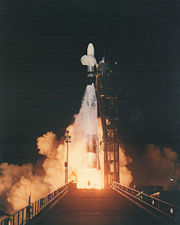
Mariner 5
Encyclopedia

Mariner program
The Mariner program was a program conducted by the American space agency NASA that launched a series of robotic interplanetary probes designed to investigate Mars, Venus and Mercury from 1963 to 1973...
that carried a complement of experiments to probe Venus
Venus
Venus is the second planet from the Sun, orbiting it every 224.7 Earth days. The planet is named after Venus, the Roman goddess of love and beauty. After the Moon, it is the brightest natural object in the night sky, reaching an apparent magnitude of −4.6, bright enough to cast shadows...
' atmosphere by radio occultation, measure the hydrogen Lyman-alpha (hard ultraviolet) spectrum, and sample the solar particles and magnetic field
Magnetic field
A magnetic field is a mathematical description of the magnetic influence of electric currents and magnetic materials. The magnetic field at any given point is specified by both a direction and a magnitude ; as such it is a vector field.Technically, a magnetic field is a pseudo vector;...
fluctuations above the planet
Planet
A planet is a celestial body orbiting a star or stellar remnant that is massive enough to be rounded by its own gravity, is not massive enough to cause thermonuclear fusion, and has cleared its neighbouring region of planetesimals.The term planet is ancient, with ties to history, science,...
. Its goals were to measure interplanetary and Venusian magnetic fields, charged particles, plasmas, radio refractivity and UV emissions of the Venusian atmosphere.
Mariner 5 was actually built as a backup to Mariner 4
Mariner 4
Mariner 4 was the fourth in a series of spacecraft, launched on November 28, 1964, intended for planetary exploration in a flyby mode and performed the first successful flyby of the planet Mars, returning the first pictures of the Martian surface...
, but after the success of the Mariner 4 mission, it was modified for the Venus mission by removing the TV camera, reversing and reducing the four solar panels, and adding extra thermal insulation.
It was launched toward Venus on June 14, 1967 from Cape Canaveral Air Force Station
Cape Canaveral Air Force Station
Cape Canaveral Air Force Station is an installation of the United States Air Force Space Command's 45th Space Wing, headquartered at nearby Patrick Air Force Base. Located on Cape Canaveral in the state of Florida, CCAFS is the primary launch head of America's Eastern Range with four launch pads...
Launch Complex 12 and flew by the planet on October 19 that year at an altitude of 3990 kilometres (2,479.3 mi). With more sensitive instruments than its predecessor Mariner 2
Mariner 2
Mariner 2 , an American space probe to Venus, was the first space probe to conduct a successful planetary encounter . The first successful spacecraft in the NASA Mariner program, it was a simplified version of the Block I spacecraft of the Ranger program and an exact copy of Mariner 1...
, Mariner 5 was able to shed new light on the hot, cloud
Cloud
A cloud is a visible mass of liquid droplets or frozen crystals made of water and/or various chemicals suspended in the atmosphere above the surface of a planetary body. They are also known as aerosols. Clouds in Earth's atmosphere are studied in the cloud physics branch of meteorology...
-covered planet and on conditions in interplanetary space.
Radio occultation data from Mariner 5 helped to understand the temperature and pressure data returned by the Venera 4
Venera 4
Venera 4 ) was a probe in the Soviet Venera program for the exploration of Venus. Venera-4 was the first successful probe to perform in-place analysis of the environment of another planet. It was also the first probe to land on another planet...
lander, which arrived at Venus shortly before it. After these missions, it was clear that Venus had a very hot surface and an atmosphere even denser than expected.
The operations of Mariner 5 ended in November 1967 and it is now defunct in a heliocentric orbit
Heliocentric orbit
A heliocentric orbit is an orbit around the Sun. All planets, comets, and asteroids in our Solar System are in such orbits, as are many artificial probes and pieces of debris. The moons of planets in the Solar System, by contrast, are not in heliocentric orbits as they orbit their respective planet...
.
Further communication attempts
Further communication attempts were tried, in a joint spacecraft solar wind / solar magnetic fields investigation with Mariner 4Mariner 4
Mariner 4 was the fourth in a series of spacecraft, launched on November 28, 1964, intended for planetary exploration in a flyby mode and performed the first successful flyby of the planet Mars, returning the first pictures of the Martian surface...
, back in communication with Earth after being out of telemetry for about a year or more around superior conjunction. During the experiment, both spacecraft were going to be on the same idealized magnetic field spiral carried out from the sun by the solar wind.
Between April and November 1968 NASA tried to reacquire Mariner 5 to continue probing interplanetary conditions.
Attempts to reacquire Mariner 5 during June, July, and early August 1968 yielded no spacecraft signal.
On October 14, the receiver operator at DSS 14 obtained a lock on the Mariner 5 signal. A carrier wave was detected, but outside expected frequency limits and varying in wavelength. Signal strength changes indicating the spacecraft was in a slow roll. Nevertheless, it was possible to lock the spacecraft to an uplink signal, but no response was observed to any commands sent to it. Without telemetry and without any signal change in response to commands, there was no possibility to repair or continue to use the spacecraft. Operations were terminated at the end of the track from DSS 61 at 07:46 GMT on November 5, 1968.
Instruments
- Two-Frequency Beacon Receiver
- S-Band Occultation
- Helium Magnetometer
- Interplanetary Ion Plasma Probe for E/Q of 40 to 9400 Volts
- Celestial Mechanics

